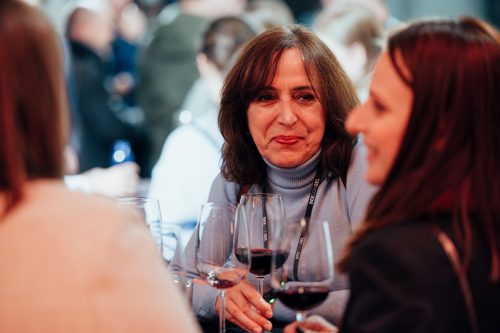Sjef van der Steen’s latest presentation at the BeeHealth symposium in Madrid 2024 June. Recording is a bit dark, sound is good – after 1 min!!
New Video podcast on INSIGNIA
Update on INSIGNIA-EU. We met in Madrid for a BeeHealth symposium where INSIGNIA-EU results were presented. We have been absent for a while, so listen to the Video podcast, where we also talk to our National Coordinators. Stay tuned…
Environmental assessment of PAHs through honey bee colonies – A matrix selection study
Alice Pinto, happy birthday

When we spot somebody having birthday in our consortium, we celebrate for sure.
We all congratulate Alice Pinto with her birthday today (16-12-2023).
Why not ask Bing’s AI. “Who is Alice Pinto”, and here it comes.
“M. Alice Pinto is a professor and a researcher from Portugal who specializes in honeybee genetics and conservation. She works at the Polytechnic Institute of Bragança and the Mountain Research Centre. She has published many papers and books on topics such as honeybee diversity, evolution, molecular research, and environmental monitoring. She is also involved in several national and international projects related to honeybee health and sustainability.”
As Alice did reply, “no reason to worry about AI, since I have done far more work in my life!”. Conclusion: AI still not an intellectual threat!
Alice with her team is an important and hardworking partner of INSIGNIA, doing the metabarcoding on all our pollen samples. A new way for pollen recognition and will become the way for pollen analysis in the future. It is still a long journey and big workload doing this and the databases are still not perfect, but after INSIGNIA a major step up is done.
Flemming Vejsnæs
Pictures are from the BeeConSel meeting in Ljubljana recently, where Alice was in the advisory board of the project.

INSIGNIA-EU podcast November 2023
Get the latest wrap-up on the INSIGNIA-EU. We answer the question – HOW FAR IS THE PROJEKT AT THE MOMENT. Enjoy.
PESTICIDES RESIDUES IN HONEY – CORRECTED VERSION OF NEWSLETTER OF THE 31TH SEPTEMEMBER
Pesticides residues in honey
Josef van der Steen
September 2023
Summary
Pesticides can be detected in honey. There is nothing that a beekeeper can do about it, because pesticides are in the environment and bees collect these pesticide residues along with their food. Based on the recent EFSA report on pesticides in food, the most detected pesticides in honey are the agricultural pesticides thiacloprid, acetamiprid, bimoxystrobin, glyphosate, chlorpyriphos, fosetyl, flonicamid, boscalid, and chlorfluazuron. The varroa control substances amitraz and coumaphos were also detected. In about 4 out of 5 honey samples no pesticides were found in quantifiable amounts, and in 1 out of 5 honeys pesticides could be detected. Only in a few cases did the amount of pesticides exceed the MRL (Maximum Residue Level) threshold, but in all cases, the honey samples analysed met the food safety / trade threshold. How pesticides enter the hive, how the honey bee colony cleans the honey, and how pesticides in honey may relate to honey consumption and toxic effects, is described in this newsletter. Continue reading “PESTICIDES RESIDUES IN HONEY – CORRECTED VERSION OF NEWSLETTER OF THE 31TH SEPTEMEMBER”
Worlds northernmost beekeeper
Sissel Goodgame is the worlds northernmost beekeeper. More then 2000 km north of Oslo, Norway. We found it so exciting to have her on the team, since she is so far away for everything – read “pollution”. On the annual Vossa møtet 2 hours from Bergen, Sissel made a great talk about her participation in the INSIGNIA project. INSIGNIA would not survive without our beekeepers or Citizens Scientist as we call them. They are all volunteers. We handed over our honor certificate for being an important part of INSIGNIA. “Sissel thanks a lot”. Hope there will be a next time and hope to have you on the team.
The diversity of the pollen image of a bee colony
Within the INSIGNIA project we did sample pollen samples from our test colonies every second week from the 20.-23. April to the end of the project 24.-27. august. Every second week the Citizens Scientist went out an activated the pollen trap on the evening before and then did empty the trap next days evening. There was always an eye on the weather forecast. Should we move the collection with one or 2 days. The main part of the samplings were done over one day, few times 2 days.
Continue reading “The diversity of the pollen image of a bee colony”
How are we doing?
Podcast on where we are after samplinground 7, we are so close to the final sampling round and there are samples all over europe on the way to the laboratories. We are so excited. So how are we doing. Listen to the sum up.
Portugal is started, even in rain!
The national coordinators of Portugal Alice Pinto and Andreia Quaresma from Instituto Politécnico de Bragança made the big tour, visiting all Citizens Scientist to support the start up of INSIGNIA sampling in Portugal. Have look on the nice video and see how and what they did. Even Portugal has “not so nice weather”. Really good investment of the coordinators. Secures a safe startup and getting closely connected to the Citizens Scientist.



